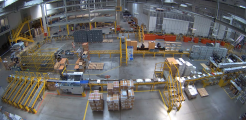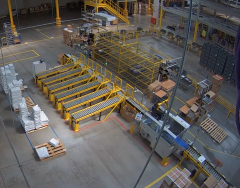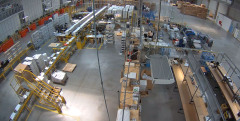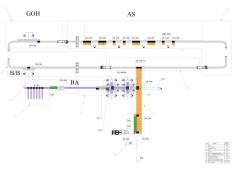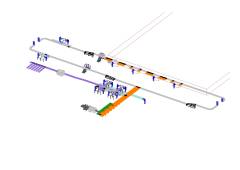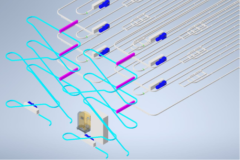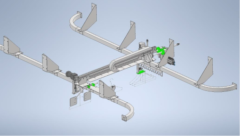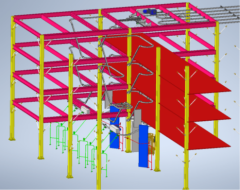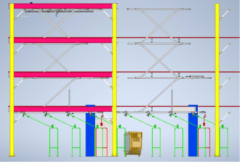Description
The goal of the research and development project is the application of knowledge in the fields of automation, electrical engineering, information technology and mechanical engineering to the design, development and testing of a new automated line for various types of clothes on hangers, with the possibility of storing and then removing 30,000 pieces of hangers on an area of 18 x 36 m , with capacity expansion to 60,000 pieces of hangers. The goal of the project is to achieve a line time of 125 items of clothing on hangers per hour. The requirements and technical parameters of the line required by the customer could not be met with the devices available on the market, and therefore the customer turned to the company for the implementation of a research and development project.
The main element of the innovation of the project is a new automated line for various types of clothes on hangers (coats, jackets, shirts, T-shirts, sweaters, etc.), which allows storing and then removing 32,400 pieces of hangers on a significantly limited area of 18 x 36 m with a time cycle of 125 hangers per hour. Commonly available automated lines on the market are designed and designed for only one type of product (e.g. only for t-shirts), or they are designed universally, where one type of bag (big bag) is designated for each hanger, into which the products are placed. The innovation of the project is also represented by the preliminary preparation of the line for increasing the capacity up to 55,440 pieces. An important element of innovation is also a manipulator with a developed gripper, which makes it possible to hang (move from one position to another) a different assortment of clothes on hangers.
The basic element of the technical uncertainty of the project is the creation of an automated line for different types of clothes on hangers (different shapes, thicknesses, materials, etc.), with the possibility of storing and then removing up to 60 thousand pieces of hangers. An essential technical uncertainty of the project is the way to measure the thickness of the material in order to clearly determine the number of positions needed for the given type of goods. A technical uncertainty is the way to sort and hang the goods, due to the diversity of the assortment. The technical uncertainty of the project is also represented by the significantly limiting installation space of the line and the problematic environment for cameras and sensors, due to the difficult lighting conditions.
The result of the research and development project is a new universal automated line for different types of clothes on hangers, which allows storing 32,400 pieces of hangers with the possibility of increasing the capacity to 55,440 pieces. The automated line has a time clock of 125 hangers per hour with a maximum waiting time for one position of about 2 minutes. The result of the project is also new knowledge and skills acquired during the implementation of the project, which the company will further use to maintain competitiveness in the field of automation, electrical engineering, information technology and mechanical engineering.
New automated line for unloading/storing various types of clothes on hangers
The main element of the innovation of the project is a new prototype of a universal automated line, which allows storing and unloading different types of clothing on hangers of different shapes, thicknesses, and materials. The automated line has a capacity of 32,400 pieces of hangers and is prepared to increase the capacity up to 55,440 pieces. There are no devices available on the market that are designed and solved for different product ranges and that meet the required technical parameters. The available solutions are intended for one type of goods (e.g. only for t-shirts), or the goods are packed in bags that have a certain volume and are individually hung on hangers. The line is constructed on a considerably limited building space of 18 x 36 meters, due to which a 3-story and 3-row construction is designed for the most efficient use of space. The line is composed of the following parts:
- take-out conveyor,
- hijackers,
- control panel (PLC) located on the electrical distribution box,
- suspension system,
- conveyors with a length of approximately 210 m,
- the station where the operator manually hangs the goods.
The hangers are hung on the carriers, the pitch of which is 33 mm. Thus, approximately 30 pcs/meter are placed on average. The suspension system includes three pieces of separate branches, where each of them has a maximum capacity of 18,480 positions at a pitch of 33 mm, i.e. the maximum capacity of the system is the above-mentioned 55,440 pieces of positions. The support structure of the line is made up of approximately 180 pieces of support columns of the yak profile 100 x 100 x 3 mm.
A new automated technological procedure for removing/storing clothes on hangers
The innovation of the project is also a new management system and a new working process of the line, by programming and synchronizing the time cycle of the line of 125 hangers per hour is achieved. The maximum waiting time for one position is 2 minutes, and the maximum line speed is 30 m/min. Unloading can take place simultaneously from all 3 floors.
In the lower station of the line, goods are manually hung and at the same time the thickness of the material is measured, so that the exact number of positions needed for a given piece of clothing can be determined. A noticeable element of the innovation of the project is the new process of measuring the thickness of the material, which consists in the use of a distance laser sensor. The sensor is set to measure a specific distance to the sheet metal wall. The clothes are pressed by the mechanism against the sheet metal wall and the distance is measured. The measured distance value is subtracted from the original distance to the sheet metal wall to calculate the resulting thickness of the garment with a tolerance of +/- 3mm and to determine the number of positions required for the garment. The hangers are different in color and contain a QR code that is scanned by the system so that the goods are not confused when they are handled. Once a week, the system checks the availability of positions (vacant, occupied) and also the presence of positions, i.e. whether the goods are in their place.
A new principle for grasping diverse clothing
An important element of innovation is the work process of the manipulator (robot) and the new gripper, which ensure a smooth and reliable transfer of hanging clothes from one position to another (hanging, sorting). The problem with manipulations is the different weight and inertia of the clothes, due to the variety of clothes. The gripper is pneumatically controlled and designed on the principle of pincers. To eliminate swinging of clothes on hangers during handling, the gripper is supplemented with white and black nylon, which increases the gripping area. To facilitate the grasping of the goods, a pneumatic mechanism is designed that opens the surrounding positions from the position ready for manipulation and thus allows better access to the given goods. During manipulations, the packaging (clothing in protective packaging) may not always be in ideal condition, so the packaging may be torn and the clothing may protrude. In order to prevent such cases, additional mechanical components are designed to ensure the required position of the package for the work of the manipulator.
Criterion of creativity
The criterion of creativity is demonstrably fulfilled on the basis of implemented activities that were not of a routine nature. Creative activity is mainly supported by the very essence of the activities of technical workers, whose knowledge and experience are based on practice. The creative activity of the project solvers is contained in the design of the prototype of the automated line for storing/unloading different types of clothes on hangers. Also in the development of the control system of the line, in the development of the control system and in the synchronization of the overall work process of the line. In order to achieve the set goals of the project, it is necessary to design and implement the design solution of the automated line, the software solution (control system), design the work process, components, perform calculations, simulations, analyses, tests and trials, verify functionality and implement several changes during development.
- Project manager.
- Programmer.
- Electrical engineer – Programmer.
- Production operator – tester.
- Constructor.
- Constructor-mechanic.
- Chief fitter.
- Developer.
Project details
| Client: | Vermont |
| City: | Sokolovce |
| Price: | 4.6 mil € |











